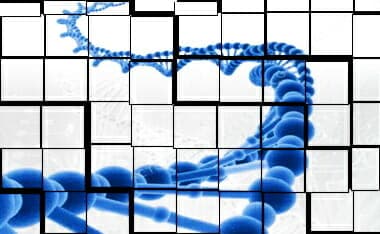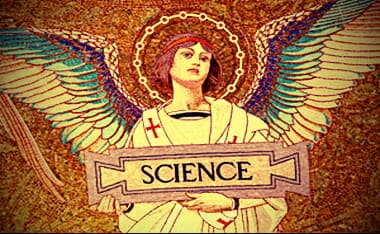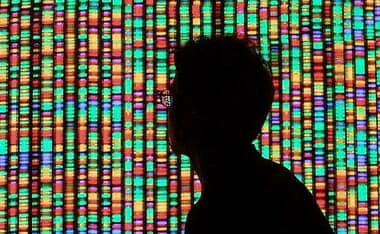Darwinism is the ruling paradigm of the scientific community. Yet, hear a world renowned scientist explain how Darwin was limited in his understanding of today’s modern scientific discoveries, and how this led to numerous mistakes on his part. But the mistakes did not stop just at science.
John Sanford


Darwin vs. Population Genetics (Of Rabbits and Illusions)
Mind you, Philip Cunningham may be a bit tough to listen to… but his attention to detail — even if he cannot pronounce “intelligentsia” — are a must. Enjoy.
(Above video description) “Darwinism provided an explanation for the appearance of design, and argued that there is no Designer — or, if you will, the designer is natural selection. If that’s out of the way — if that (natural selection) just does not explain the evidence — then the flip side of that is, well, things appear designed because they are designed.” ~ Richard Sternberg – Living Waters documentary
Whale Evolution vs. Population Genetics – Richard Sternberg and Paul Nelson – (excerpt from Living Waters video) [POSTED BELOW]
The abject failure of Natural Selection on two levels of physical reality – VIDEO (2016) (princess and the pea paradox & quarter power scaling)
(Above video description) THE ORIGIN OF MAN AND THE “WAITING TIME” PROBLEM – John Sanford – August 10, 2016
Excerpt: My colleagues and I recently published a paper in Theoretical Biology and Medical Modeling, “The Waiting Time Problem in a Model Hominin Population.” It is one of the journal’s “highly accessed” articles. A pre-human hominin population of roughly 10,000 individuals is thought to have evolved into modern man, during a period of less than six million years. This would have required the establishment of a great deal of new biological information. That means, minimally, millions of specific beneficial mutations, and a large number of specific beneficial sets of mutations, selectively fixed in this very short period of time. We show that there is simply not enough time for this type of evolution to have occurred in the population from which we supposedly arose.
Historically, Darwin-defenders have argued that time is on their side. They have claimed that given enough time, any evolutionary scenario is feasible. They have consistently argued that given millions of years, very large amounts of new biologically meaningful information can arise by the Darwinian process of mutation/selection. However, careful analysis of what is required to establish even a single genetic “word” (a short functional string of genetic letters) within a hominin genome shows just the opposite. Even given tens of millions of years, there is not enough time to generate the genetic equivalent of the simplest “word” (two or more nucleotides). Even in a hundred billion years, much longer than the age of the universe, there is not enough time to establish the genetic equivalent of a very simple “sentence” (ten or more nucleotides). This problem is so fundamental that it justifies a complete re-assessment of the basic Darwinian mechanism.

Cornell University Professor Talks Bias, Faith, and Science
WIKI Bio
Sanford graduated in 1976 from the University of Minnesota with a BSc in horticulture. He went to the University of Wisconsin–Madison where he received an MSc in 1978 and a PhD in 1980 in plant breeding/plant genetics. Between 1980 and 1986 Sanford was an assistant professor of Horticultural Sciences at Cornell University, and from 1986 to 1998 he was an associate professor of Horticultural Science. Although retiring in 1998, Sanford continues at Cornell as a courtesy associate professor. He held an honorary Adjunct Associate Professor of Botany at Duke University. Sanford has published over 70 scientific publications in peer reviewed journals.
Creation WIKI bio
Dr. John C. Sanford (1950-) is the Associate Professor of Horticultural Sciences (semi-retired) at Cornell University, New York State Agricultural Experiment Station. Dr. Sanford is a researcher in genetics and is currently presently looking at the theoretical limits of mutation andselection.
He graduated in 1976 with a BS in Horticulture from the University of Minnesota. Two years later Dr. Sanford graduated with a MS in Plant Breeding/Plant Genetics from the University of Wisconsin. He then went on to earn his Ph.D. in Plant Breeding/Plant Genetics from the University of Wisconsin in 1980.
Dr. Sanford is a former atheist. Since the mid-1980s, Sanford has looked into theistic evolution (1985–late 1990s), Old Earth creationism (late 1990s), and Young Earth creationism (2000–present). According to him, he did not fully reject Darwinian evolution until the year 2000. Dr. Sanford and his wife Helen have three children.
On behalf of intelligent design, Dr. Sanford was involved in the 2005 Kansas evolution hearings. He denied the principle of common descent and testified …”that we were created by a special creation, by God.”
As an inventor, Dr. Sanford holds more than 25 patents including the biolistic process known as the “gene gun.” He started two biotech enterprises derived from his research, Biolistics, Inc., and Sanford Scientific, Inc. In addition to his genetic contributions, Dr. Sanford and his colleagues developed the quantitative forward genetic modeling program called Mendel’s Accountant. Sanford et al. published two peer reviewed papers dealing with genetic entropy in computing journals concerned with modeling methodology. Based on quantitative modeling evidence developed using Mendel’s Accountant and from his research into mutations, Sanford holds that the genome is deteriorating and therefore could not have evolved in the way specified by the modern evolutionary theory suggests.
His research into the genetic limit of the genome, and it’s devolution has lead to the publishing of “Genetic Entropy & the Mystery of the Genome”.
After mostly retiring from Cornell, Dr. Sanford has started a small nonprofit, the Feed My Sheep Foundation, which focuses on supporting science and technology research initiatives in the area of life sciences.

“[Current] Creationist Contributions to Science” ~ Dr. Don Batten
A few examples of current men of science who are young earth creationists:
- Professor Dr Bernard Brandstater—pioneer in anesthetics. Amongst many other achievements, he pioneered assisted breathing for premature babies with prolonged incubation and developed an improved catheter for epidural anesthesia, both adopted around the world.
- Prof. Stuart Burgess—a world expert in biomimetics (imitating design in nature). He is Professor of Engineering Design, Department of Mechanical Engineering, University of Bristol (UK) and leads the Design Engineering Research Group at the university. Dr Burgess is the author of over 40 papers published in science journals, and another 50 conference proceedings. He has also registered 7 patents and has received various awards, the Wessex Institute Scientific Medal being the most recent.
- Professor Dr Ben Carson—pioneer pediatric neurosurgeon. He was long-term director of pediatric neurosurgery at the Johns Hopkins Medical Institutions. He was the first surgeon to successfully separate conjoined twins joined at the head and also pioneered surgery to cure epilepsy in young children, and much else. He has been awarded 51 honorary doctorates, including from Yale and Columbia universities in recognition of his outstanding achievements. He is a member of the Alpha Honor Medical Society, the Horatio Alger Society of Distinguished Americans, and sits on numerous business and education boards. In 2001, CNN and Time magazine named Ben Carson as one of the nation’s 20 foremost physicians and scientists. In that same year, the Library of Congress selected him as one of 89 ‘Living Legends’. In February 2008, President Bush awarded Carson the Ford’s Theater Lincoln Medal and the Presidential Medal of Freedom, the USA’s highest civilian honors.

- Dr Raymond Damadian—largely responsible for developing medical imaging using magnetic resonance (MRI). He has been honored with the United States’ National Medal of Technology, the Lincoln-Edison Medal, and induction into the National Inventors Hall of Fame alongside Thomas Edison, Alexander Graham Bell and the Wright brothers. In 2001 the Lemelson-MIT program bestowed its lifetime achievement award on Dr Damadian as “the man who invented the MRI scanner”. It is commonly recognized that he was discriminated against in not at least sharing a Nobel Prize for his work (two others shared the award), although Damadian was the discoverer that diseased tissue would have a different signal from healthy.’
- Dr John Hartnett—developed the world’s most precise atomic clocks, which are used in research and industry around the globe. He is an Australian Research Council (ARC) Discovery Outstanding Researcher Award (DORA) fellow at the University of Adelaide, where he is an Associate Professor. In his relatively short career, he has published more than 200 papers in scientific journals, book chapters, and conference proceedings.
- Dr Raymond Jones—solved the major problem of the indigestibility of Leucaena (a tropical legume) for grazing cattle in Australia, among other achievements. This research has contributed hundreds of millions of dollars to the Australian beef industry. He was honored with the CSIRO Gold Medal for Research Excellence, and the Urrbrae Award.
- Dr Felix Konotey-Ahulu—many pioneering contributions, especially in sickle cell disease management. He is Kwegyir Aggrey Distinguished Professor of Human Genetics, University of Cape Coast, Ghana, and Consultant Physician Genetic Counsellor in Sickle Cell and Other Haemoglobinopathies, Phoenix Hospital Group, London, UK. Ironically, sickle cell disease is often incorrectly held up as a ‘proof of evolution’ in science textbooks. Dr Konotey-Ahulu has received many awards in recognition of his work.
- Dr John Sanford—has been granted over 30 patents arising from his research in plant breeding and genetics. His most significant scientific contributions involve three inventions, the biolistic (`gene gun’) process, pathogen-derived resistance, and genetic immunization. A large fraction of the transgenic crops (in terms of both numbers and area planted) grown in the world today were genetically engineered using the gene gun technology developed by John and his collaborators. Dr Sanford was honoured with the Distinguished Inventor Award by the Central New York Patent Law Association in 1990 and 1995)
- Dr Wally (Siang Hwa) Tow—groundbreaking research in ‘molar pregnancy’, a poverty-related disease. He was invited to lecture in some fourteen top Obstetrics-Gynaecology departments in America in 1962-3, including leading universities such as Harvard, Johns Hopkins, Columbia, New York, UCLA, Cornell, and Stanford. He was awarded the William Blair Bell Lectureship by the RCOG in recognition of the importance of this work. He served as Professor and Chairman of the Department of Obstetrics and Gynaecology, National University of Singapore.
Don Batten, “Creationist Contributions to Science,” Creation 36(4):1 September 2014, 17-18. See also, creation bios.

Human Genome in Meltdown ~ Is the Genome Project Proving a Genesis Date?
Here is some awesome info via Creation/Evolution Headlines:
According to a study published Jan. 10 in Nature by geneticists from 4 universities including Harvard, “Analysis of 6,515 exomes reveals the recent origin of most human protein-coding variants.” By recent they mean really recent on evolutionary timescales:
We estimate that approximately 73% of all protein-coding SNVs [single-nucleotide variants] and approximately 86% of SNVs predicted to be deleterious arose in the past 5,000–10,000 years. The average age of deleterious SNVs varied significantly across molecular pathways, and disease genes contained a significantly higher proportion of recently arisen deleterious SNVs than other genes.
The authors explained this in evolutionary terms as the result of “explosive population growth” and that “selection has not had sufficient time to purge them from the population.” They claimed Europeans had more variants “consistent with weaker purifying selection due to the Out-of-Africa dispersal.” The last paragraph assesses the impact of their findings:
More generally, the recent dramatic increase in human population size, resulting in a deluge of rare functionally important variation, has important implications for understanding and predicting current and future patterns of human disease and evolution. For example, the increased mutational capacity of recent human populations has led to a larger burden of Mendelian disorders, increased the allelic and genetic heterogeneity of traits, and may have created a new repository of recently arisen advantageous alleles that adaptive evolution will act upon in subsequent generations.
As for advantageous mutations, they provided NO examples.
Dr. John Sanford Interviewed About His Book, “Genetic Entropy and the Mystery of the Genome“
Continuing with Creation/Evolution Headlines post:
The findings depend on models and assumptions, but appear to support the thesis of John Sanford’s book Genetic Entropy and the Mystery of the Genome, which argues that the genetic load increases so rapidly that mankind could not have survived for tens of thousands of years, to say nothing of millions (see recent YouTube interview part 1 and part 2 [combined into one, above]). How can such rapid rate of degradation be sustained over evolutionary time?
The authors seemed a bit baffled by their findings. The following paragraph gives a hint of that (compare “expected” vs observed):
The site frequency spectrum (SFS) of protein-coding SNVs revealed an enormous excess of rare variants (Fig. 1a). Indeed, we observed an SNV approximately once every 52 base pairs (bp) and 57 bp in European Americans and African Americans, respectively, whereas in a population without recent explosive growth we would expect the SNVs to occur once every 257 bp and 152 bp in European Americans and African Americans, respectively (Supplementary Information). Thus, the European American and African American samples contain approximately fivefold and threefold increases in SNVs, respectively, attributable to explosive population growth, resulting in a large burden of rare SNVs predicted to have arisen very recently (Fig. 1b). For example, the expected age of derived singletons, which comprise 55.1% of all SNVs, is 1,244 and 2,107 years for the European American and African American samples, respectively. Overall, 73.2% of SNVs (81.4% and 58.7% in European Americans and African Americans, respectively) are predicted to have arisen in the past 5,000 years. SNVs that arose more than 50,000 years ago were observed more frequently in the African American samples (Fig. 1b), which probably reflects stronger genetic drift in European Americans associated with the Out-of-Africa dispersal.
